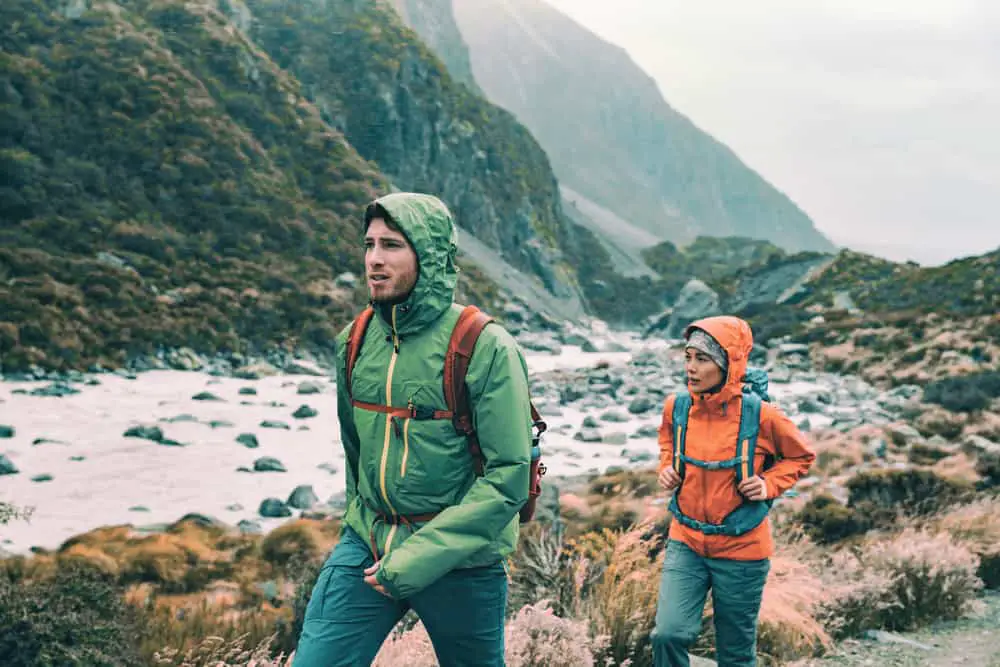If you want the most effective and comfortable jacket for your situation it’s important to understand the available options. Two popular jacket types are hardshell jackets and rain jackets.
Read on as we explore the differences between the two jackets, including how they are constructed, what each jacket type features, and what their sub-types are used for.
Quick Jacket Comparison
Here are some of the features and differences between hardshell and rain jackets.
| Hardshell Jacket | Rain Jacket | |
| Features | Performance fits, larger hoods, taller collars, longer back, zippable vents, zippered pockets | Adjustable hoods, two or three pockets, waist cincher |
Hardshell Jackets
Hardshell jackets are usually bulkier and more aligned with inclement weather and intense performance.
Construction
Hardshell jackets are known to be more durable and waterproof than other types of jackets, and they use three layers to protect the wearer from the elements.
Closest to the skin is a soft inner liner that helps protect the middle layer from moisture like sweat and oil coming off the skin. This is usually a thinner layer, and it helps keep the rougher fabric from coming in contact with skin.
The middle layer is tightly woven to be simultaneously waterproof and breathable. It keeps moisture out and lets sweat escape.
While Gore-Tex is the most common brand, you will also see,
- eVent
- H2No Performance Standard
- Ascent Shell
The outer shell is the fabric that directly combats weather conditions, and it is usually thicker than other jackets. There is a durable water repellent finish that causes water and snow to roll right off the surface.
Additional Features
Hardshell jackets are designed for weather conditions, and you will find plenty of features including:
- Larger hoods capable of accommodating helmets
- Taller collars to deter rain, sleet, and snow
- Longer backs to protect from snow
Some jackets feature zippers in the armpit area to improve breathability and create vents in the jacket. Pockets are also likely to be zippered to protect the insides from collecting snow. These are usually higher up to work better with backpack hip belts and/or climbing harnesses.
Different Types
Hardshell jackets can be split into three general groups.
The minimalist style uses thinner materials and comes with fewer features. This is one step up from a rain jacket but still uses three layers to combat acclimate weather conditions.
The all-around types are a great middle-ground that allow you to move around in harsher conditions without adding on that much weight. These are great if you are spending more time out in rain or snow, but do not need to tote around a heavy-duty jacket.
Alpine hardshell jackets are much more burly and contain features you didn’t even know you needed. These jackets are built for extreme conditions like high mountain environments, and you usually feel much more secure in one.
Rain Jackets
Rain jackets closely resemble jackets used for daily wear, and they are designed to primarily tackle rain, sleet, or snow with no extensive weather conditions.
Construction
A rain jacket uses two layers to get the job done: a breathable waterproof membrane and a shell. Some fancier brands will include a light inner layer for comfort, but this is more mesh than anything else.
The outer shell resembles that of the hardshell jacket, but with less rigidity. You still benefit from a durable water repellent finish and sealed seams, but the fabric should be lighter and easier to move in.
The inside layer of a rain jacket is a waterproof membrane that still allows your skin to breathe so you aren’t retaining sweat or oils. For most rain jackets this layer will come in contact with your skin, and it is less rigid than the one in the hardshell jacket.
Additional Features
Rain jackets are usually designed to fit your body, and they come with adjustable hoods and waist cinchers. Most have at least two or three pockets, but these sit as they would on a normal jacket and do not always have zippers.
Some rain jackets have helmet compatibility and zipper vents, but these are usually the ones that toe the line between hardshell jackets and rain jackets. Most are better suited for casual daily wear.
Different Types
Ultralight jackets are the most streamlined and the thinnest, and they weigh the least. These are much lighter than other jackets, and may even be lighter than casual non-rain jackets.
Daily use jackets bulk it up a bit and will provide a better fit with hood and cuff adjustments. These are still light enough to carry in your bag on a hiking trip without increasing your load by much.
Hiking rain jackets give you plenty of protection, but they are still light enough to leave room for mobility. Hiking rain jackets are more likely to include zipper vents to help you regulate your body temperature.
Performance rain jackets are one step down from hardshell jackets, and they are designed to handle more extreme conditions. These have a durable shell fabric and a more breathable waterproof barrier, and most can handle thick beanies or even helmets underneath.
Hardshell vs. Rain Jacket – Which Is Better?
When looking at hardshell jackets and rain jackets head to head it is clear which jacket types work well in different situations.
A hardshell jacket will give you better protection from the weather, especially in harsh rain or snow. These jackets are more breathable and durable, and they provide better comfort if you need to manage moisture.
Rain jackets are easier to carry and wear, and they work well in situations where you do not need intense weather protection. These can be more comfortable for hiking and light wear, and they are a much cheaper option.
Understanding what you will be dealing with in terms of weather and mobility will help you decide which jacket is best for your situation.


